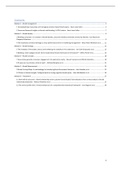Samenvatting
Summary papers Brand Management 2021
- Instelling
- Tilburg University (UVT)
A clear summary of all 12 papers for the course Brand Management for the MScs Marketing Management/Analytics at Tilburg University. If you have questions, don't hesitate to ask me!
[Meer zien]




